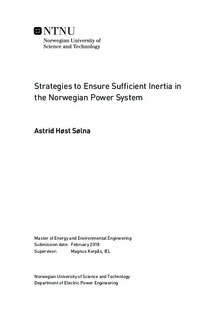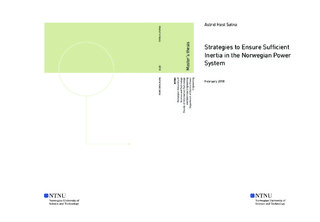| dc.description.abstract | Having a stable system frequency is vital for safe operations of a power system. A small change in frequency is adjusted for by the system inertia. Inertia is the ability of the rotating masses of a synchronous machine to resist a change in frequency. The system inertia has the important ability that it helps maintain a stable frequency. The consequence of an unstable frequency can in the worst case be a blackout.
The Nordic power system is changing, and it is expected that these changes will lead to more occurrences of low inertia situations. Low inertia situations must be avoided as they lead to a more unstable frequency. To avoid low-inertia situations it is necessary to introduce measures to increase the inertia in the Nordic power system.
Three strategies to ensure sufficient inertia in the Norwegian power system will be evaluated based on their socioeconomic costs and their effectiveness in providing sufficient inertia. The aim of the thesis was to find a cost-effective strategy for the Norwegian power system. To analyze the effect of the strategies, a market model of the Northern European power system was used.
Defining a minimum production level for the hydro generators proved an effective strategy in ensuring sufficient inertia. The socioeconomic costs related to this strategy were however, high. Extending the strategy to only apply on days with low inertia gave satisfying results: the inertia was increased on the days it was needed and the costs of the strategy were reduced. Reducing the capacity on an HVDC link gave lower socioeconomic costs. The strategy has a positive effect on the system inertia, as long as there is import on the HVDC link when the capacity is reduced. The best economic outcome was estimated to come from load reduction by disconnecting the pumps for hydro storage. This strategy has however limited availability.
The results show that low inertia situations in the Norwegian power system can be avoided by taking necessary measures. Imposing a minimum production level on days with low inertia proved an effective strategy to increase the system inertia. Looking at the cost-effectiveness, load reduction by disconnecting the pumps for hydro storage or reducing the capacity of an HVDC-link are better options. However, the capability of these latter strategies to provide the inertia depend on external factors giving them a somewhat limited applicability. | |

